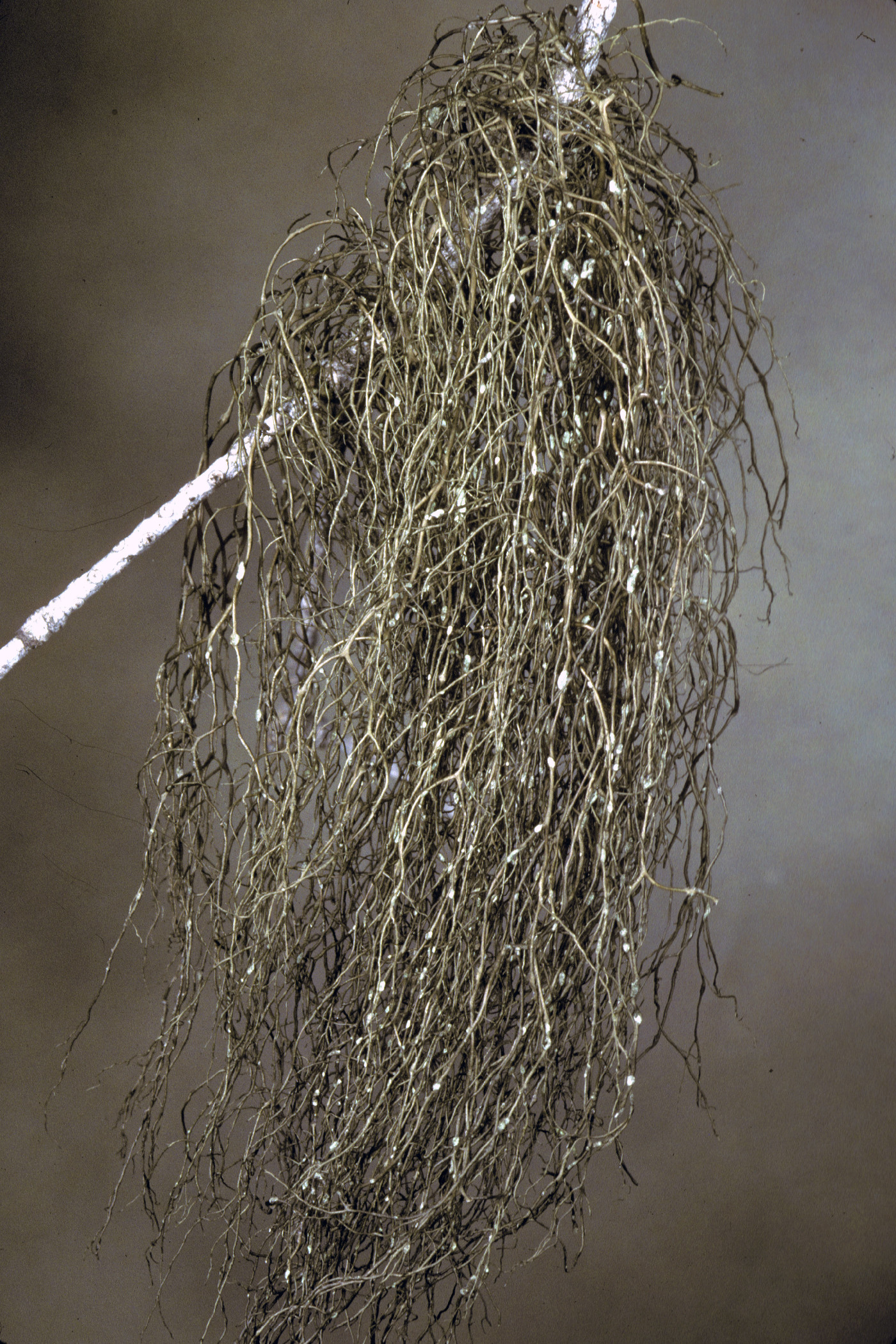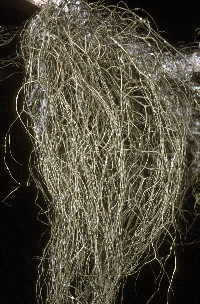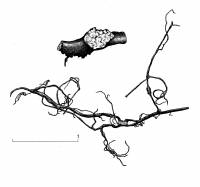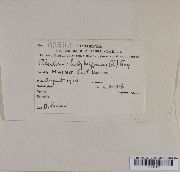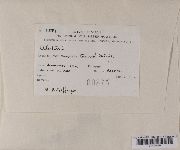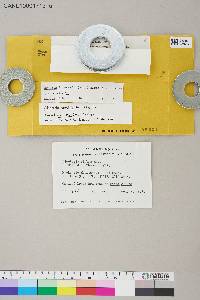
Consortium of Lichen Herbaria
- building a Global Consortium of Bryophytes and Lichens as keystones of cryptobiotic communities -
- Home
- Search
- Images
- Species Checklists
- US States: O-Z >
- US National Parks
- Central America
- South America
- US National Parks
- Southern Subpolar Region
|
|
|
|
Family: Parmeliaceae
[Alectoria cana (Ach.) Leight., moreAlectoria chalybeiformis (L.) Gray, Alectoria chalybeiformis f. buekkensis Gyeln. & Fóriss, Alectoria chalybeiformis f. chalybeiformis (L.) Röhl., Alectoria chalybeiformis f. lanestris (Ach.) Hue, Alectoria chalybeiformis f. nigrescens Gyeln., Alectoria chalybeiformis f. prostrateosteola (Gyeln.) Keissl., Alectoria chalybeiformis f. prostratosteola (Gyeln.) Keissl., Alectoria chalybeiformis f. terrestris Stizenb., Alectoria haynaldii Gyeln., Alectoria implexa (Hoffm.) Nyl., Alectoria jubata f. tenerrima Cromb., Alectoria jubata var. lanestris Ach., Alectoria jubata var. subcana (Nyl. ex Stizenb.) Nyl., Alectoria lanestris (Ach.) Gyeln., Alectoria lanestris f. achariana (Gyeln.) Zahlbr., Alectoria lanestris f. haynaldii (Gyeln.) Zahlbr., Alectoria lanestris f. lanestris (Ach.) Gyeln., Alectoria lanestris f. prostratosteola (Gyeln.) Zahlbr., Alectoria lanestris var. achariana (Gyeln.) Gyeln., Alectoria lanestris var. lanestris (Ach.) Gyeln., Alectoria positiva (Gyeln.) Motyka, Alectoria prolixa var. subcana Stizenb., Alectoria prostratosteola Gyeln., Alectoria subcana (Nyl. ex Stizenb.) Gyeln., Alectoria subcana f. subcana (Nyl. ex Stizenb.) Gyeln., Alectoria subcana f. subfusca Gyeln., Alectoria subcana f. subosteola (Gyeln.) D. Hawksw., Alectoria subcana var. bicolorata Motyka, Alectoria subcana var. fuscidula (Arnold) Motyka, Alectoria subcana var. obscurata Motyka, Alectoria subcana var. osteola (Gyeln.) Motyka, Alectoria subcana var. subcana (Nyl. ex Stizenb.) Gyeln., Alectoria subcana var. subfusca (Gyeln.) Motyka, Alectoria subcana var. subosteola (Gyeln.) Motyka, Bryopogon capillaris (Ach.) Bystrek, Bryopogon chalybeiformis (L.) Link, Bryopogon chalybeiformis f. chalybeiformis (L.) Link, Bryopogon chalybeiformis f. lanestris (Ach.) M. Choisy, Bryopogon chalybeiformis f. pallidum Savicz, Bryopogon haynaldii (Gyeln.) Gyeln., Bryopogon haynaldii f. acharianus (Gyeln.) Gyeln., Bryopogon haynaldii f. carpaticus Gyeln., Bryopogon haynaldii f. haynaldii (Gyeln.) Gyeln., Bryopogon haynaldii f. nitidiusculus Gyeln., Bryopogon haynaldii f. osteologriseus Gyeln., Bryopogon haynaldii f. subacharianus (Gyeln.) Gyeln., Bryopogon jubatus f. lanestris (Ach.) Oxner, Bryopogon jubatus var. chalybeiformis (L.) Rabenh., Bryopogon lanestris (Ach.) Gyeln., Bryopogon lanestris f. acharianus (Gyeln.) Gyeln., Bryopogon lanestris f. canadensis Gyeln., Bryopogon lanestris f. haynaldii (Gyeln.) Gyeln., Bryopogon lanestris f. lanestris (Ach.) Gyeln., Bryopogon lanestris f. prostratosteolus (Gyeln.) Gyeln., Bryopogon pacificus Gyeln., Bryopogon prostratosteolus (Gyeln.) Gyeln., Bryopogon subcanus (Nyl.) Gyeln., Bryopogon subcanus var. bicoloratus (Motyka) J. Bystrek{?} & J. Bystrek{?}, Bryopogon subcanus var. obscuratus (Motyka) J. Bystrek{?} & J. Bystrek{?}, Bryopogon subcanus var. subcanus (Nyl.) Gyeln., Bryopogon subosteolus Gyeln., Bryoria chalybeiformis (L.) Brodo & D. Hawksw., Bryoria chalybeiformis f. chalybeiformis (L.) Brodo & D. Hawksw., Bryoria chalybeiformis f. prostratosteola (Gyeln.) D. Hawksw., Bryoria haynaldii (Gyeln.) Bystrek, Bryoria lanestris (Ach.) Brodo & D. Hawksw., Bryoria subcana (Nyl. ex Stizenb.) Brodo & D. Hawksw., Lichen chalybeiformis L., Parmelia jubata var. chalybeiformis (L.) Ach., Setaria jubata var. chalybeiformis (L.) Samp., Usnea chalybeiformis (L.) Baumg.] |
Nash, T.H., Ryan, B.D., Gries, C., Bungartz, F., (eds.) 2002. Lichen Flora of the Greater Sonoran Desert Region. Vol 1. Thallus: prostrate or decumbent, usually 8-15 (-20) cm long branching: isotomic dichotomous towards the base but becoming anisotomic dichotomous towards the apices, often entangled, angles between the dichotomies mainly obtuse branches: irregular, often sparse towards the base, main branches: much larger than the secondary ones, sometimes straight but usually becoming twisted and foveolate or sometimes channeled, occasionally flattened, (0.3-) 0.5-1.0 (-2.0) mm diam. surface: dark brown to olive-black, sometimes paler towards base, usually shiny; true lateral spinules absent but irregular, spinulose branches sometimes present soralia: absent or sparse, usually tuberculate, occasionally becoming spinulose, usually narrower than the branches on which they occur; pseudocyphellae absent Apothecia and Pycnidia: unknown Spot tests: cortex and medulla K-, C-, KC-, usually P-, UV-; soralia P+ red Secondary metabolites: fumarprotocetraric acid (usually in the soralia only). Substrate and ecology: on base-rich or acid rocks and soil, occasionally on lignum, rarely on conifers, in exposed intermontane localities at all elevations, usually montane to alpine, rare in maritime regions World distribution: circumpolar, apparently bipolar Sonoran distribution: rare in Arizona on granite or soil, 2680-3050 m. Notes: This species is distinguished from B. fuscescens (which normally grows on bark but has been reported to occur occasionally on soil or rock) mainly by the coarser, darker and often shiny main stems (Krog 1980). The few specimens from the Sonoran region that can be assigned to B. chalybeiformis are rather poorly developed and somewhat pale and slightly reddish (rather than greenish) tinged, but fit here better than under B. fuscescens. Nash, T.H., Ryan, B.D., Gries, C., Bungartz, F., (eds.) 2002. Lichen Flora of the Greater Sonoran Desert Region. Vol 1. Thallus: pendent (to prostrate in some morphotypes of var. positiva), relatively lax, usually 5-15 (-30) cm long, moderately branched branching: isotomic or anisotomic at the base, often becoming anisotomic toward the apices, frequent from the base; axils: acute (to obtuse, but generally not broadly rounded) branches: terete, to sometimes partly flattened or twisted and occasionally foveolate (in var. positiva), somewhat unevenly (to evenly) thickened, (0.2-) 0.3-0.4 (-0.6) mm in diam. near its base, but main or secondary branches often 0.1 mm diam. surface: pale to medium brown or somewhat grayish or olivaceous, to blackish, usually much paler at the base than at the apices, often with black fragmentation regions, often dull but sometimes quite shiny; pseudocyphellae: lacking; lateral, spinulose branches sometimes present but inconspicuous; true lateral spinules: lacking soralia: sparse or abundant, fissural (sometimes resembling pseudocyphellae when young) or sometimes also tuberculate, often strongly convex at maturity, sometimes becoming spinulose, usually white Spot tests: cortex and medulla K-, C-, KC-, UV-, P- or P+ red (v. positiva); soralia: P+ red-orange Secondary metabolites: fumarprotocetraric and protocetraric acids (and accessory chloroatranorin in specimens from eastern North America). Substrate and ecology: on bark, mostly of conifers in dry and open forests (Pinus ponderosa and Pseudotsuga forests); var. positiva has also been reported from lignum, and from rocks in highly exposed sites World distribution: circumpolar and boreal and in the East African mountains Sonoran distribution: Arizona, c. 2875-3400 m, in pine and spruce-fir forest. Notes: It is characterized mainly by P+ red-orange soralia, mostly V-shaped axils, and typically grayish brown and often dull surface, which is usually paler at the base. The thallus is often pendulous but rarely forms long, thick beards. It is an extremely variable species and is treated here in a very broad sense. Most material from the Sonoran region tends to have much finer branches than previously described (Brodo and Hawksworth 1977), and is therefore often very difficult to distinguish from the frequently intermixed B. lanestris, The only other Bryoria known from North America that has P+ red soralia and very narrow branches is B. subcana, which has a pale gray to brown, short thallus (up to 5 cm long) and is found in maritime areas well north of the Sonoran region. Some collections included here under B. fuscescens appear to be mixtures of short, very pale thalli with ± longer and/or darker ones. The palest (almost whitish) ones may represent basal or dying parts, but have a rather different appearance. Coarser, darker, or shorter forms of B. fuscescens from exposed habitats can be similar to B. chalybeiformis, that primarily occurs on rock or soil. Bryoria fuscescens is usually more grayish brown, and have tuberculate soralia. Nash, T.H., Ryan, B.D., Gries, C., Bungartz, F., (eds.) 2002. Lichen Flora of the Greater Sonoran Desert Region. Vol 1. Thallus: pendent to subpendent, 5-10 (-15) cm long, very brittle (fragmenting in herbarium packets) branching: irregular, isotomic to anisotomic dichotomous, frequent from the base; axils: usually acute branches: most c. 0.1 mm diam.; main branches (and basal ones, Sonoran material): 0.1-0.25 (-0.3) mm diam., sometimes becoming compressed toward the base, but straight, neither contorted nor foveolate surface: brown-black or olive blackish or black, usually concolorous and dull; lacking pseudocyphellae and true lateral spinules; soralia: sparse to abundant, fissural, mostly rather inconspicuous in Sonoran material, white or often speckled with black, up to 0.3 mm long Apothecia and Pycnidia: not seen in North American material Spot tests: cortex and medulla: K-, C-, KC-, UV-, P-; soralia: P+ orange or red Secondary metabolites: fumarprotocetraric acid (and protocetraric acid). Substrate and ecology: usually on conifers World distribution: circumboreal in the Northern Hemisphere; reports from Algeria and Mexico are dubious Sonoran distribution: common in Arizona, usually on Picea engelmannii or Abies lasiocarpa in forests at 2900-3400 m. Notes: As presently circumscribed this species is often very difficult to distinguish from B. fuscescens, with which it is often closely entangled. At least in populations from northern areas, B. lanestris characteristically is very unevenly thickened and has quite brittle branches with strictly fissural soralia, that are frequently larger than the branch diameter and is often black-spotted. However, in Sonoran populations the consistently thinner branches and the often dull, uniformly dark olive-blackish surface (without paler basal parts) seem to be the most consistent distinguishing features of B. lanestris. Another frequent difference between B. lanestris and B. fuscescens is that in B. lanestris the axils are acute even at the base, such that the branches tend to lie mostly parallel to each other and form narrow (c. 3 mm across) strands. |
|
|
|
Powered by Symbiota

